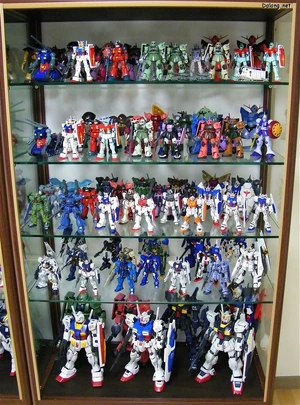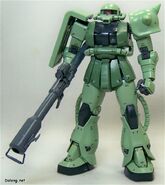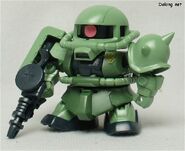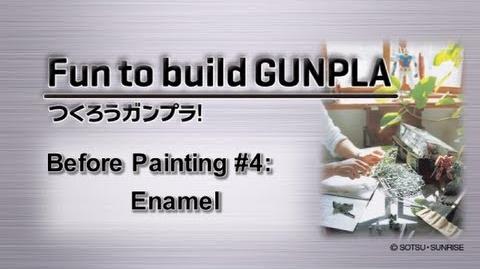m (clean up, typos fixed: eg: → e.g.:) |
m (→Ecopla: Added a detail.) |
||
| Line 61: | Line 61: | ||
===Ecopla=== |
===Ecopla=== |
||
| − | A special limited release sold at events such as the "Gundam Expo." With the exception of clear parts, the kits are made from recyclable materials. |
+ | A special limited release sold at events such as the "Gundam Expo." With the exception of clear parts, the kits are made from recyclable materials; specifically, melted-down plastic left over from the manufacture of other models. |
==Comparison== |
==Comparison== |
||
Revision as of 05:31, 28 November 2013

Gunpla gallery showing various grades and scales. Courtesy of Dalong's Gunpla Review.
Gunpla (ガンプラ Ganpura, a Japanese portmanteau of "Gundam"and "plastic model") refers to plastic and non-plastic model kits that have become popular among anime fans and model-lovers, especially in Japan and in other nearby Asian countries since 1980s. The popularity of Gundam models increased in 1990s with North America and Europe being exposed to Gundam through television, video and manga.
Plastic Gunpla
Plastic Gundam model kits are manufactured by Bandai in Japan (or China) which has an exclusive license in manufacturing and marketing the kits around the world. The first plastic Gundam model kits were sold in 1980 in Japan.
Plastic Gundam model kits consist of several trays of parts or "runners" that either snap-fit (most post-1990 models) or require glue (older models prior to 1990) to put together. The cover image on the box, or box art, is usually done by an illustrator with a picture illustration of the subject mecha design in action. All plastic Gundam models kits are supplied with stickers and sometimes decals to apply extra colors and markings as seen in the show, movies, manga or video games. Smaller or lower grade kits often require paint to give the model a finished appearance.
The kits range in different scales with the most popular scales being: 1:144 (approx 13 cm tall), 1:100 (approx 16–19 cm tall) and 1:60 (approx 30 cm tall).
Since the first Gundam model sold, there has been a constant improvement in quality design, material and manufacturing technique by Bandai. The basic 20 year old kits (routinely re-released by Bandai, with some exceptions) require cement and paint. These kits when completed, have very limited range of motion which renders them almost not poseable. These models were retrospectively called FG (First Grade).
High Grade
Later the quality of the moulding was improved and HG (High Grade) level kits were introduced in 1990. These kits at either 1:144 or 1:100 scale, provide for better range of motion and greater poseability. It is important to note that the SEED and SEED DESTINY 1:100 scale models do not have HG listed anywhere on the box or manual, but they are considered HG in terms of quality.
Master Grade
The next level are designated MG (Master Grade, introduced in 1995) and are only offered in 1:100 scale. These kits are manufactured using higher quality plastic and the resulting molds are of a greater standard. However, the model is more expensive, complicated and takes longer to construct. The finished models offer a superior range of motion compared to the lower level kits to provide for an even wider range of poses. Some of them actually include specially designed stands for added display ability. Master Grade kits are very presentable assembled straight from the box, but adding paint and detailing can greatly improve the appearance of the finished model.
Perfect Grade
The highest quality kits are known as PG (Perfect Grade, introduced in 1998). These 1:60 scale models are made of even higher quality plastic and metal components. These kits include parts that have to be secured with screws, and often require some minor wiring for small LEDs. The market for the Perfect Grade level of models is limited due to the higher cost, often topping $200. Perfect Grade models are a true challenge and their construction can take a few days.
High Grade Universal Century
The highly anticipated HG Universal Century series, commonly called the HGUC series, was released in May 1999. Created in an easy to collect 1/144 scale, it represented a chance to release versions of many Mobile Suits for the first time in kit form using refined designs and modern injection moulding technology. The high quality of the HGUC series makes it the rightful heir of the HG series released in the 1990s. New designs, with new mechanical improvements, continue to be introduced in the series even today. Furthermore, all modern 1/144 HG models, such as the Gundam SEED line, are built to the same quality of early HGUC models. Starting in 2010 the HGUC line incorporated mobile suits from the alternate timelines that had not received a HG. The first two models to be released with the new lineup are the HGAW GX-9900 Gundam X released on April 15 and the GF13-017NJII God Gundam to be released in May.
Real Grade
In July 2010, Bandai introduced the 1:144 Real Grade (RG) line as part of the "Gundam 30th Anniversary", which takes design elements from the Master Grade and Perfect Grade line such as an inner skeletal frame. This Gunpla line achieves the largest range of motion in each joint.
Super-Deformed
Also offered is an expanding line of small plastic kits labelled SD Gundam (Super-Deformed Gundam) which are not presented in a particular scale. "SD" Gundams are comedic renditions of the various Gundam mecha designs featuring a disproportionately large "head." These kits are often much easier to construct but offer very limited possibility and require paint and detailing to truly "finish" the kit. The most famous line is the BB Senshi (known as SD GUNDAM BB Warriors in Bandai's English page). Depending on popularity of series, SD units may also be sold in separate product line (e.g.: Superior Defender Gundam Force).
Bandai also offers Real Detail model kits, which is exclusive to the Cosmic Era universe. While the scale is 1:60, they are basically scaled up HG kits with some added details. The level of details and possibility are not comparable to Master Grade and Perfect Grade kits, but some models feature gimmicks like light up LEDs and includes a stand.
Bandai often produce limited run kits for special events (JAFCON, C3 or locale specific events.) These kits are generally packaged differently from normal production kits, but usually differ only in that they are fabricated with metal plating or in translucent plastic.
Non Plastic Gunpla
Bandai has also released some Gundam garage kit under their branch, B-club. These models are composed of unpainted resin with no decals provided, often needing modification by the modeler due to the inherent properties of the manufacturing process. While comparably more expensive (some surpassing $400) compared to plastic kits, they offer an unparalleled level of detail for the dedicated and experienced model builder.
A few select kits have also appeared manufactured from metal. These kits are offered by several different manufacturers and most commonly will result in a finished model of about MG level.
These types of models (real detail) Usually take days to build.
Other series
EX Model
This line depicts vehicles in supporting roles, such as tanks and fighters. They are less expensive than garage kits, yet have higher detail than regular plastic models. Although they are usually in 1:44 scale, vessels such as the Argama and White Base are in 1:1700. Other series featured in this line include Patlabor, Sentō Yōsei Yukikaze, and Ace Combat.
UC HardGraph
Released in 2006, it uses the 1:35 scale for armored fighting vehicles. Kits can be bundled with soldiers, firearms, vehicles and MS parts.
Speed Grade Collection
A series launched in 2007, it is a single-color kit molded in the 1:200 scale.
Mega Size Model
A large-sized product in the 1:48 scale, it was first released in March 6, 2010 as part of the Gundam 30th Anniversary. The "Mega Size Model Gundam" is based on the Green Tokyo Gundam Project (Gundam front) 1/1 full-size model.
AG (Advanced Grade)
Released in 2011 with the Mobile Suit Gundam AGE series, it comes with a Gage-ing Chip for the Gage-ing Battle Base arcade game.
Ecopla
A special limited release sold at events such as the "Gundam Expo." With the exception of clear parts, the kits are made from recyclable materials; specifically, melted-down plastic left over from the manufacture of other models.
Comparison
The following are all the equivalent sets of an MS-06 Zaku II each demonstrating a different series of Gunpla Model Kits.
Video Gallery
See also
- Gundam Fix Figuration
- Real Grade
- List of 80's Scale Gunpla models
External links
- Gunpla on Wikipedia
- Bandai Hobby Site (English version)
- Hobby Link Japan (Huge Japanese online hobby store.)
- Dalong's Gunpla Review -Avid Gunpla and Giant Robot model collector.













